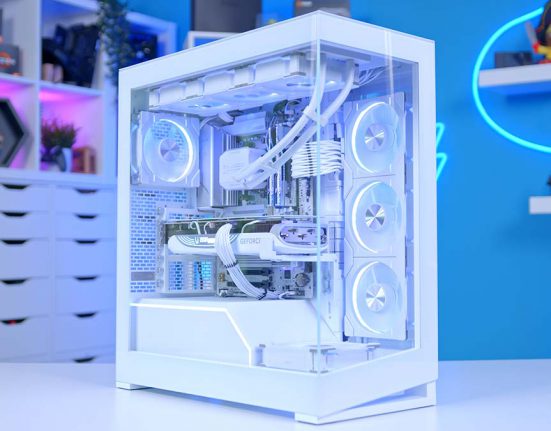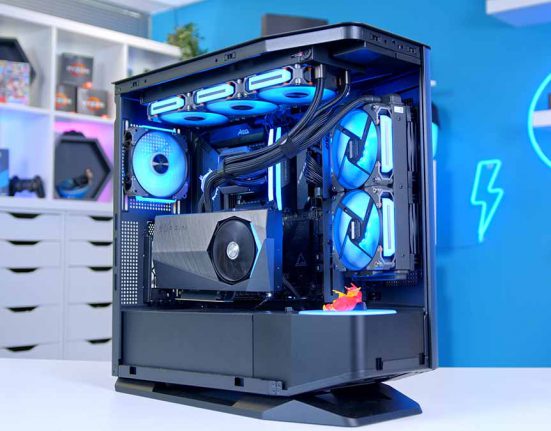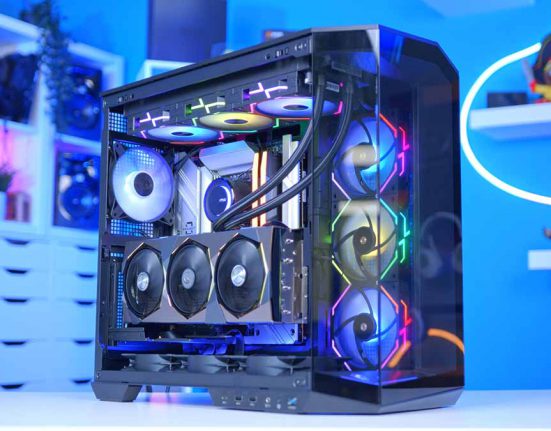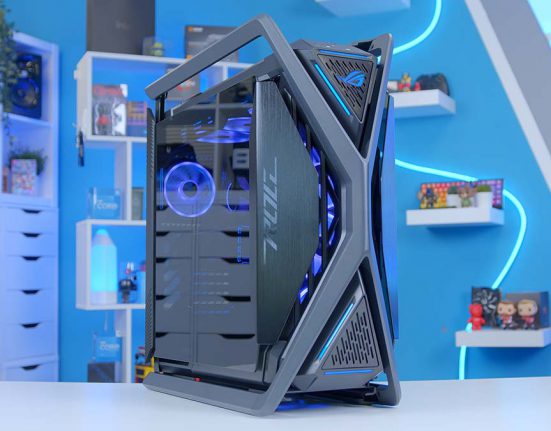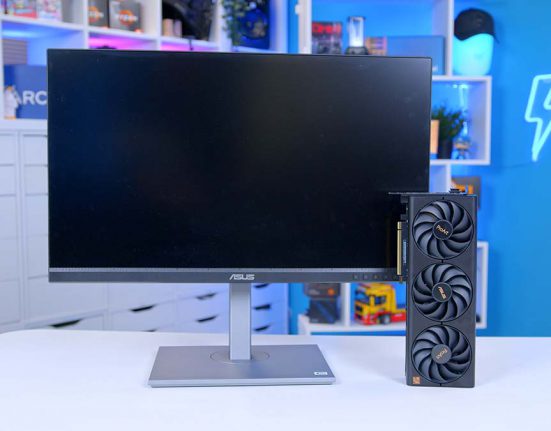If you are looking for a new GPU for 1440p gaming, you’ll be pleased to hear that options are plentiful. With four times more gamers opting to game at 1440p than 4K, it is no wonder GPU manufacturers AMD and NVIDIA are so keen to dominate with this space. That is exactly what the new RTX 4070 SUPER from NVIDIA aims to do, become the GPU of choice for budding 1440p gamers, and fend off the ever growing popularity of the AMD RX 7800 XT, this card’s direct rival.
Announced at CES 2024, alongside a refreshed RTX 4070 Ti SUPER and RTX 4080 SUPER line-up, NVIDIA are clearly keen to build on their impressive consumer GPU sales, with hopes a mid-life refresh in the answer that consumers and board partners alike are seeking. It is an approach that makes sense too, given how solid the Ada Lovelace architecture has proved itself, and how complete rival AMD’s GPU line-up now seems to be.
In this review we’ll be looking at the new RTX 4070 SUPER in the context of a hotly competitive component market, evaluating the cards performance in a wide range of titles, and looking at whether this GPU is one worth considering compared to other options.
Specifications
The RTX 4070 SUPER looks to bolster core counts and clock speeds when compared to the vanilla RTX 4070. Interestingly, the RTX 4070 SUPER will look to directly completely against the standard RTX 4070 chip, with it being the only high-end non SUPER variant to remain: the RTX 4070 Ti and RTX 4080 will cease to be sold once existing stock and supply chains run dry.
Specifically, the RTX 4070 SUPER delivers an 21% uplift in CUDA cores, with an additional 56 RT and 184 Tensor cores to boot. Power consumption remains largely unchanged, with a small boost up to 220W, compared to 200W on the RTX 4070, while the chip inside the GPU is the full-fat AD104.
| Specification | RTX 4070 SUPER |
|---|---|
| Video Memory | 12GB GDDR6X |
| Memory Bus | 192-bit |
| Core Clock Speed | 1.98GHz |
| Boost Clock Speed | 2.48GHz |
| CUDA Cores | 7168 |
| RT Cores | 56 |
| Tensor Cores | 224 |
| Power Consumption | 220W |
| MSRP | $599 |
The amount of memory, and the memory bandwidth, remains the same on this card at 12GB. This puts it 4GB below the RX 7800 XT which has 16GB, but proved sufficient across the board in our 1440p gaming benchmarks. That isn’t to say the extra 4GB of VRAM on the RX 7800 XT won’t prove handy in years to come, with game VRAM usage on the up, but in the present landscape we don’t see it causing an issue.
| Spec | RTX 4070 | RTX 4070 SUPER | RTX 4080 |
|---|---|---|---|
| Video Memory | 12GB GDDR6X | 12GB GDDR6X | 16GB GDDR6X |
| Memory Bus | 192-bit | 192-bit | 256-Bit |
| Core Clock Speed | 1.92GHz | 1.98GHz | 2.21GHz |
| Boost Clock Speed | 2.47GHz | 2.48GHz | 2.51GHz |
| CUDA Cores | 5888 | 7168 | 9728 |
| Tensor Cores | 184 | 224 | 304 |
| RT Cores | 46 | 56 | 76 |
| Power Consumption | 200W | 220W | 320W |
| MSRP | $549 | $599 | $1199 |
What is RTX SUPER?
While a range of SUPER GPU refreshes was not seen with the previous RTX 3000 series, it is not the first time NVIDIA have employed the user of SUPER branding on their GPUs. Back in July 2019, NVIDIA launched a range of RTX 20 Series SUPER cards to build on the success of RTX 20 series. The line-up delivered a performance uplift on three GPUs, with small boosts to core counts and a memory boost on just one of the cards, the RTX 2060 Super.
The RTX 4000 series SUPER GPUs look to follow a similar pattern. Core counts across the line-up are present, but are not a substantial increase, while VRAM is only notched up on one of the GPUs – the RTX 4070 Ti. We have seen promising price adjustments this time around, though – something which looks to make these cards more competitive than their predecessors. This pricing strategy also includes an official price drop to the existing RTX 4070 design, though this only mirrors discounts already seen from many retailers in the weeks before the SUPER launch.

On the whole, we think these price adjustments from NVIDIA make a lot of sense, with the RTX 4070 SUPER delivering more performance than its predecessor for the same price. While the trimmed down RTX 4070 drops $50 to align directly against the AMD RX 7800 XT – a card that has proved popular since it’s launch at Gamescom in 2023.
The RTX 4080 SUPER sees a price drop too of $200, a pretty staggering reduction and one of a scale not seen from NVIDIA in a long time. The RTX 4070 Ti SUPER holds its price, being the only GPU to spare any adjustment. This coincides with the RTX 4070 Ti SUPER being the only card to see a VRAM boost, extra expenditure NVIDIA are clearly intent on recovering in what is presently a very competitive market.
| Model Name | MSRP |
|---|---|
| RTX 4060 | $299 |
| RTX 4060 Ti 8GB | $399 |
| RTX 4060 Ti 16GB | $499 |
| RTX 4070 | $549 |
| RTX 4070 Super | $599 |
| RTX 4070 Ti | $799 |
| RTX 4070 Ti Super | $799 |
| RTX 4080 | $1199 |
| RTX 4080 Super | $999 |
| RTX 4090 | $1599 |
While this review is centred around the RTX 4070 SUPER, the price drop on the RTX 4080 SUPER is one to watch out for, and the biggest surprise for us.
Design
We have looked at a number of different RTX 4070 SUPER models, and you can learn the differences between all of these cards in our roundup of the Best RTX 4070 SUPER designs. The primary focus of this review is of the Founders Edition card, otherwise known as NVIDIA’s in-house design.
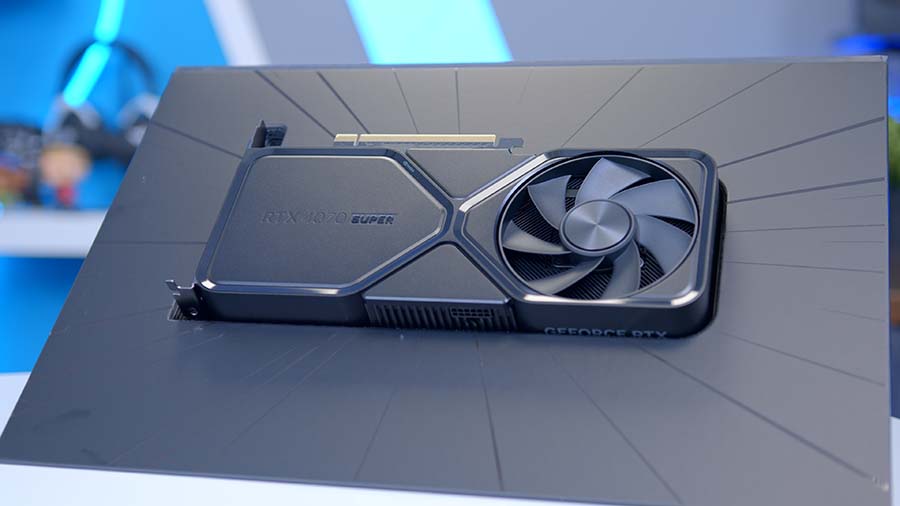
Produced directly by the engineers at NVIDIA, the Founders Edition card is one that has proved popular since it’s introduction in RTX 20 series. Often being one of the more compact designs of the bunch, NVIDIA look to bring a sleek aesthetic, restrained design and high quality materials to the top of the priority list.
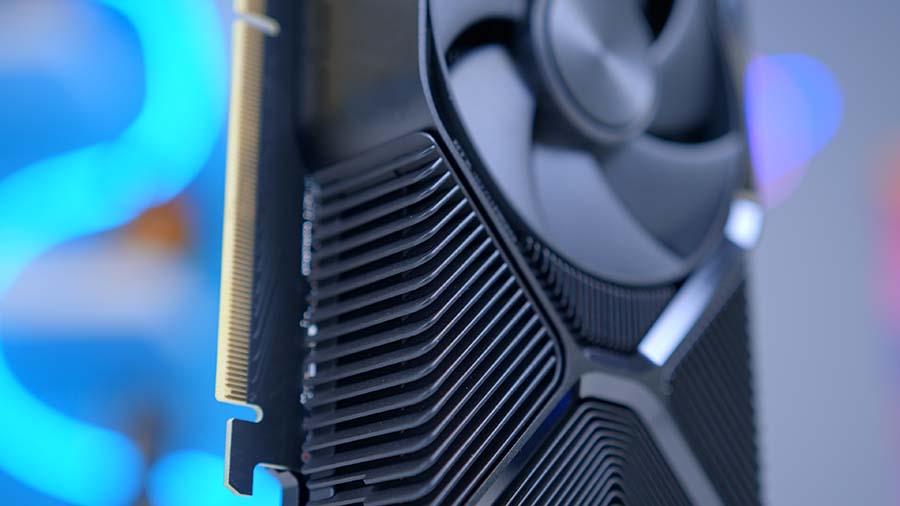
The RTX 4070 SUPER Founders Edition is no exception, with a stealthy all-black take on the otherwise familiar 40 series Founders Edition design. It is notably compact, especially when compared to large cards the like RTX 4080 and RTX 4090, and will be easy to match with most build aesthetics.

Performance
To evaluate the performance of the RTX 4070 SUPER, our in-house benchmarking expert Harry Coleman put the RTX 4070 SUPER through it’s paces in more than 15 gaming benchmarks, comparing it to a huge dataset of competitor cards. Our testing includes more than 20 other GPUs, but the below table highlights the GPUs to keep a particularly close eye on, as the best potential alternatives to the RTX 4070 SUPER.
| GPU Name | Availability |
|---|---|
| AMD Radeon RX 7700 XT | $449 |
| AMD Radeon RX 7800 XT | $499 |
| NVIDIA RTX 4070 | $549 |
| NVIDIA RTX 4070 SUPER | $599 |
| NVIDIA RTX 4070 Ti | $799 |
| NVIDIA RTX 4070 Ti SUPER | $799 |
Hogwarts Legacy
Settings: 1440p, Effects High, Material High, Fog High,Sky High, Foliage High, Post Process High, Shadows High, Textures High, View Distance High, Population High, Anti Aliasing TAA High, Windowed Fullscreen
In Hogwarts Legacy the RTX 4070 SUPER offered up an average framerate of 104FPS. Hogwarts Legacy can be quite a demanding title, but the RTX 4070 SUPER was able to push through and offer us a very smooth gaming experience across the board. Compared to the rest of the market, the RTX 4070 SUPER sits very close to the RX 7800 XT, offering a slight performance improvement of 2 frames.
We’re also seeing a massive uplift in frames when compared to the original RTX 4070, where the SUPER offers around 20 extra frames, pushing us beyond the 100FPS mark.
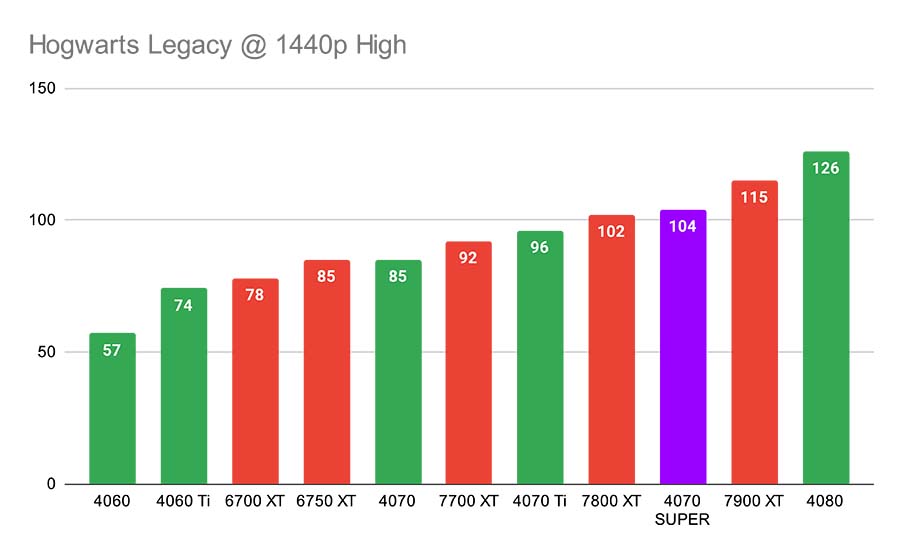
Starfield
Settings: 1440p, Shadow Quality High, Indirect Lighting High, Reflections High, Crowd Density High, Particle Quality High, Volumetric Lighting High, Motion Blur off, GTAO Quality High, Grass Quality High, Contact Shadows High VSync Off, DLSS/FSR OFF
In Starfield at 1440p high settings, the RTX 4070 SUPER yet again shows very capable rasterized performance, offering up 88FPS on average. We are seeing slightly diminished numbers here, and this is down to the optimisation issues of Starfield. But despite this, the RTX 4070 SUPER still held up very well within this benchmarking run, further showing its capability versus the RX 7800 XT with an uplift of about 5 frames.
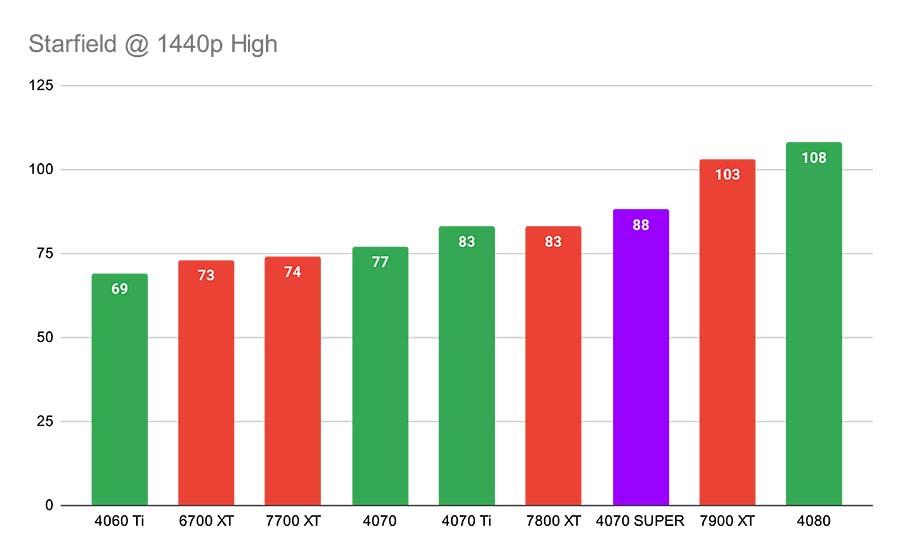
Cyberpunk 2077
Settings: 1440p, Shadow Quality High, Indirect Lighting High, Reflections High, Crowd Density High, Particle Quality High, Volumetric Lighting High, Motion Blur off, GTAO Quality High, Grass Quality High, Contact Shadows High VSync Off, DLSS/FSR: On/Off, Ray Tracing: On/Off, Textures: High
In Cyberpunk 2077 at 1440p high, we ran two separate benchmarks for the RTX 4070 SUPER, one with ray tracing and DLSS enabled, and one without. With ray tracing and DLSS 3.0 switched on we saw a 75FPS average from the RTX 4070 SUPER, placing it in between the RTX 4070 and RTX 4070 Ti. Admittedly, our numbers were very close here, with the RTX 4070 SUPER only offering a 9 frame increase versus the standard RTX 4070.
With DLSS and ray tracing switched off, our rasterized performance numbers rose to 102FPS, with the RTX 4070 SUPER offering smooth gameplay throughout. Without ray tracing, the AMD cards have much more of a chance here, as ray traced performance does seem to suffer quite significantly.
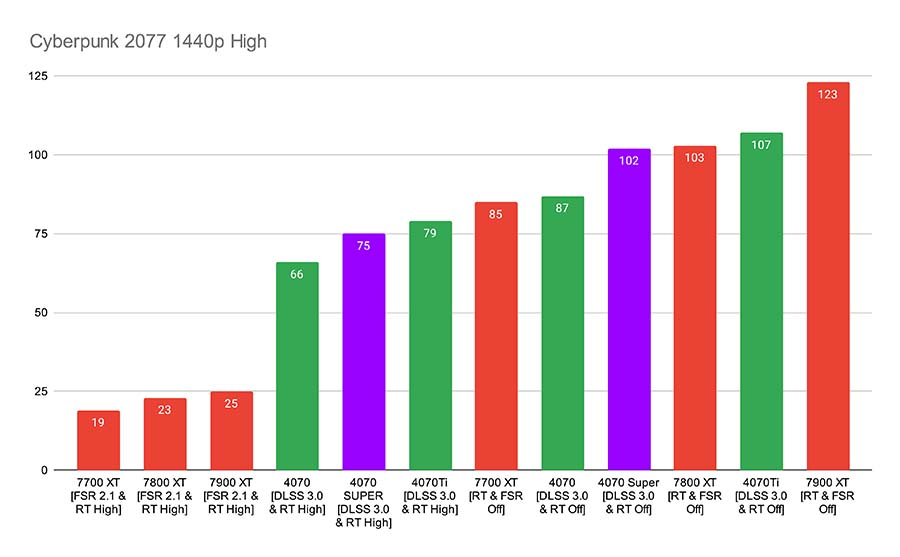
COD Warzone
Settings: 1440p, Upscaling/Sharpening FSR 2.1/DLSS Quality (80 Sharpness), Texture Resolution High, Texture Filter Anisotropic High, Level of Detail High
In COD Warzone at 1440p high with DLSS enabled, the RTX 4070 SUPER cements itself as a top-end performer, offering 157FPS on average. In this title, we’re seeing how close the RTX 4070 SUPER comes to RX 7900 XT, which is a GPU with a significantly higher price tag. The RTX 4070 SUPER is offering a marginal uplift versus the RTX 4070 Ti, with a lead of 3 frames. While the RX 7800 XT sits more than 10 frames below the average output of the RTX 4070 SUPER, missing out on that 144Hz sweet spot.
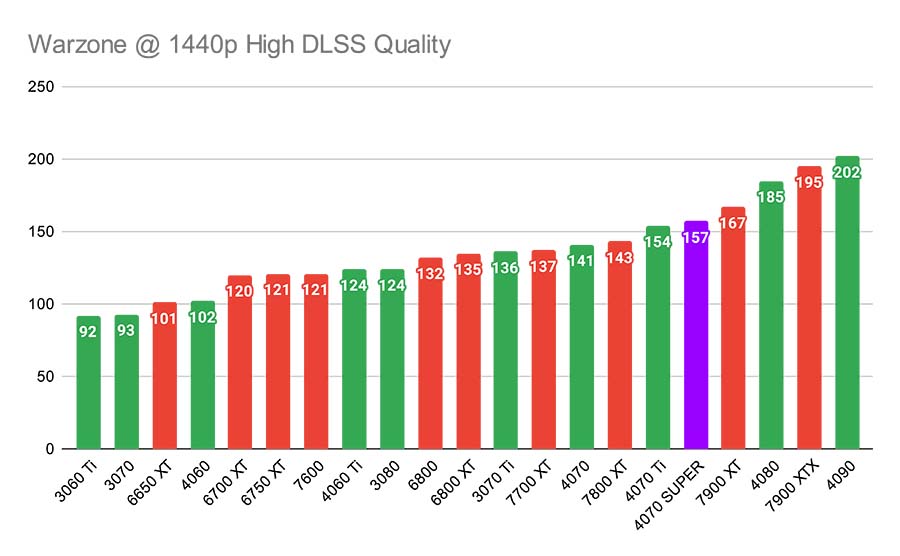
COD MW2
Settings: 1440p, Texture Resolution High, Texture Filter Anisotropic High, Level of Detail High
In COD MW2, we switched on DLSS yet again, and saw the performance of the RTX 4070 SUPER absolutely fly. This card yet again beats out the RX 7800 XT by a meagre 2 frames, with our average reaching 180FPS. Admittedly this is a negligible difference when compared to the RX 7800 XT, but we’re seeing consistent 10%-15% performance uplifts from the RTX 4070 SUPER compared to its predecessor, which showcases the rasterized performance uplift with these new refreshed cards.
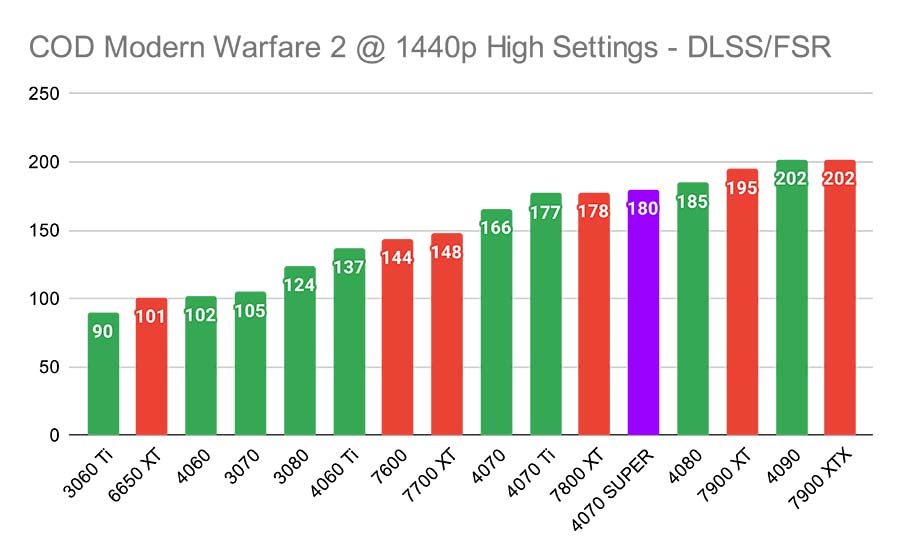
Alan Wake 2
Settings: 1440p, Post-Processing High, Texture Resolution High, Texture Filtering High, Volumetric Lighting High, Global Illumination Quality High, Shadow Detail High, Terrain Quality High, Ray-Tracing: Disabled, DLSS: On/Off, Frame Generation: On/Off
In Alan Wake 2 at 1440p high settings, the RTX 4070 Super was able to offer a 95 framerate average with ray tracing and DLSS 3 enabled. Compared to the RTX 4070, we’re seeing a difference of about 9 frames, which is pretty negligible at this level. We were pretty impressed that the vanilla RTX 4070 held up so well with ray tracing enabled.
DLSS 3.0 is clearly putting in some hard work within the ray tracing benchmark, as our raw rasterized performance numbers are pretty similar, with only 7 frames between each result.

Apex Legends
Settings: 1440p, Anti-aliasing TSAA, Texture Filtering 8X, Model Detail High, VSync Disabled, Effects High, Ambient Occlusion Quality High
In Apex Legends at 1440p high, the RTX 4070 SUPER saw an impressive average framerate of 235FPS, placing it in between the RX 6950 XT, and RX 7800 XT. Framerate really matters in Apex Legends, due to the high intensity battles you’ll find yourself in, so its great that the RTX 4070 SUPER was able to offer high performance well above the 200FPS mark. In this benchmark, we’re still seeing the RTX 4070 SUPER beat out the RX 7800 XT, which seems to be a consistent theme across all of our runs.
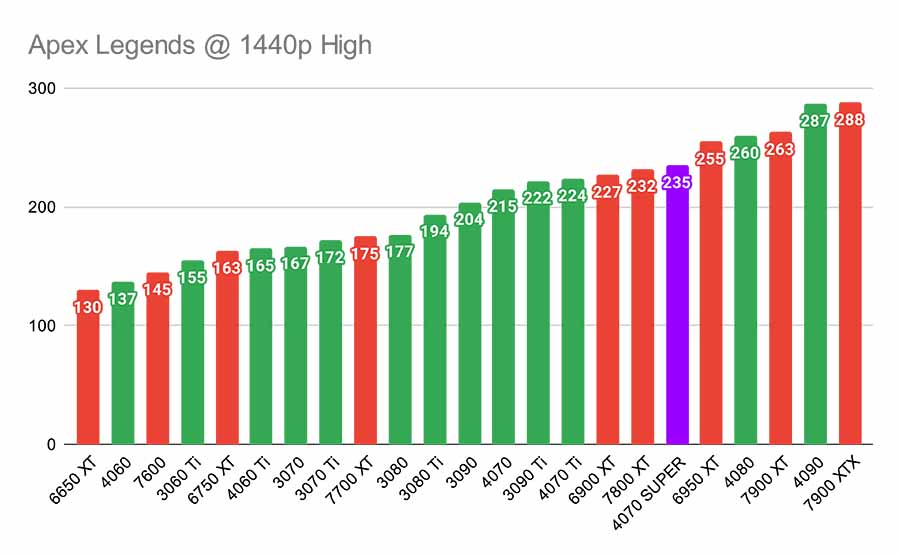
F1 2022
Settings: 1440p, Ray Tracing Quality Medium, Lighting Quality Ultra High, Post Process High, Shadows Ultra High, Weather Effects Ultra High, Ambient Occlusion HBAO+, Asynchronous Compute On, Texture Streaming Ultra High, Anisotropic Filtering 8x, DLSS: Enabled
In F1 2022, which is our last 1440p benchmark within this review, the RTX 4070 SUPER offered a staggering 241FPS, putting it in second place at this resolution. The RTX 4070 SUPER was extremely impressive within this title, beating out pretty much all of the modern 1440p capable options besides the RX 7800 XT, where it lost by 1 frame.
F1 2022 is another title which demands high framerates so that you can react quickly during a race, so the 241FPS average we’re seeing is excellent. Compared to the original RTX 4070, we’re seeing around a 25FPS difference in total, which is around an 11% performance improvement.
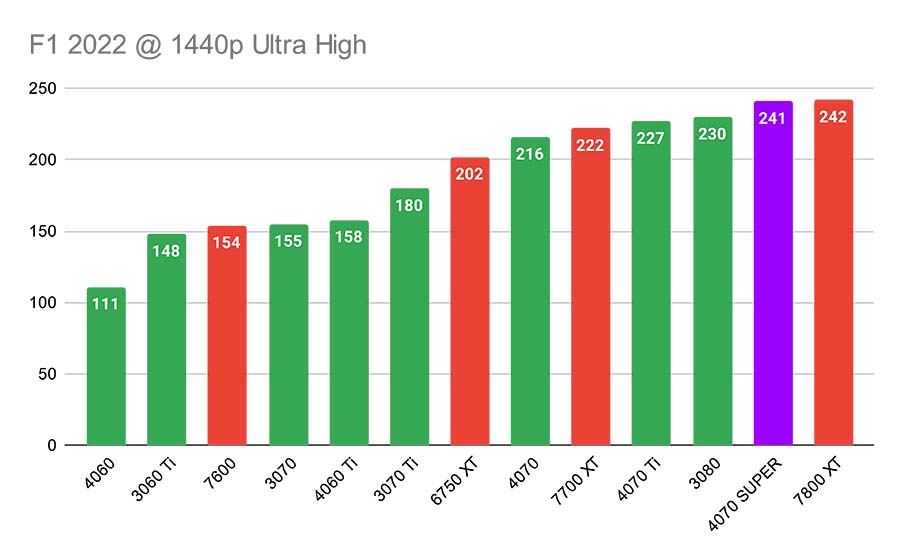
Fortnite
Settings: 1080p, Quality Low, Anti-aliasing & Super Resolution TSR High, Temporal Super Resolution Performance, View Distance Far, Textures Low
In our final benchmark we ran Fortnite at 1080p competitive settings, which saw an average framerate of 303FPS from the RTX 4070 SUPER. We run this benchmark to see how far frames can fly, but this also gives us an indicator of what kind of performance a GPU can offer when it is fully let off the chain.
The RTX 4070 SUPER sat very close to the RX 7800 XT, offering just a 1FPS increase in comparison to this card. The vast majority of gamers aren’t going to need framerates that reach this high, but when let off the leash, the RTX 4070 SUPER has proven how capable its hardware is across a plethora of popular games.

Should You Wait for RTX 5000?
Addressing a future GPU launch within the review of a new card is not something we would typically do, but the landscape of a mid-life refresh makes this a point we should probably address. Being half way through the RTX 4000 life-cycle, the prospect of RTX 5000 is one many will look on the horizon towards and wish to weigh up. Latest rumours suggest that the code name ‘Blackwell’ GPU launch will land at the end of this year, or early on in 2025.
It is impossible to accurately speculate at this point with regards to performance, but the pattern of recent GPU releases from both AMD and NVIDIA suggests any future RTX 5000 release is unlikely to dominate when compared to existing RTX 4000 series options.
The best GPU is one you can buy right now. You can always spend time looking at what is coming, but should focus on what is available now, and what is said to be imminently available, rather than looking months in to the future.
It should also be noted that the current GPU landscape is one of the most price competitive we have seen in the last 4 years, making now a great time to pick up a GPU. Early adopters of RTX 4000 have paid the higher prices, and we wouldn’t anticipate prices falling any further in the immediate term.
Conclusion
NVIDIA RTX 4070 SUPER Founders Edition
-
Features
-
Design
-
Performance
-
Value For Money
Summary
The RTX 4070 SUPER offers substantial performance gains over the RTX 4070 it looks to replace, and does so at the same, competitive $599 MSRP. In our testing, the RTX 4070 SUPER faced little trouble in achieving competitive frame rates in AAA and esports titles alike.
Hefty improvements to the number of CUDA cores, RT cores and Tensor cores deliver between a 10% and 20% performance uplift across a wide range of titles, and mimic more the performance found on the RTX 4070 Ti. This makes the RTX 4070 SUPER the best value GPU of the 40 series line-up, as things stand.
The only major downside with the RTX 4070 SUPER is VRAM. With 12GB of video memory, you are left with 4GB less than on this card’s direct competition, the cheaper RX 7800 XT. While this will prove largely sufficient for now, titles are only becoming more and more VRAM dependent, leaving the RTX 4070 SUPER susceptible to performance issues down the line.
Pros
✅ Ray tracing performance
✅ Improves performance over RTX 4070
✅ Efficient power consumption
Cons
❌ Less VRAM than 7800 XT
❌ $100 more than RX 7800 XT
❌ Simplistic design



